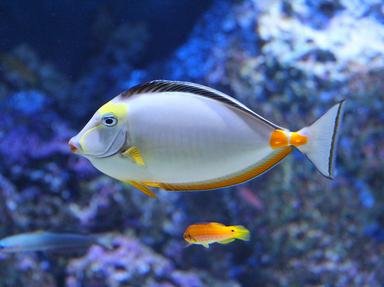Quiz Answer Key and Fun Facts
1. One of the most commonly found members of the centrarchid family in the United States, this species is usually stocked as forage for larger fishes in ponds and lakes. It bites readily on live bait such as earthworms or insects and will attack small artificials with vigor. A black spot on the posterior base of both dorsal and anal fins is the best way to identify this species.
2. Many do not realize that this species, the largest in the family, is actually a sunfish. It is one of the most sought after game fish in the U.S. and has many colloquial nicknames such as lineside bass and green trout.
3. This is one of the only centrarchids that utilizes snails as a main part of its diet. Which is why in some parts of the U.S., it is called shellcracker. This species is less prone to hit artificials, so the best way to catch them is with live bait fished on the bottom.
4. This fish is a tough little fellow that can tolerate a wide range of environmental conditions and is often the first sunfish species to repopulate depleted areas. It likes to lurk in the shadows and ambush its prey. It can be identified by its thick, greenish body, large mouth and irregular emerald-blue cheek lines.
5. This is the most visually stunning of the sunfish family. Adult males usually have turquiose blue bodies and flaming red or orange breasts. Females tend to be less boldly colored. Due to its small size, this fish is often used as bait on trotlines. They can also be identified by their long and flexible gill flaps.
6. Often called the yellowbelly sunfish, this centrarchid is native to eastern U.S. streams, but has been widely introduced throughout the nation. It can be definitively identified by its extremely long and narrow gill flap. It is one of the few sunfish that can be commonly caught at night.
7. This is another brightly colored sunfish. It has an orangish-red breast and belly with a brownish to olive green back and sides. They are speckled with orange, yellow, blue and emerald spots. They can be identified further by a crimson halfmoon on the rear edge of the gill flap.
8. Sometimes called the bronze bass or brownies, this is another popular sport fish in the sunfish family. Some people consider them to be the finest fighters, pound for pound, of any fish. They prefer clear water lakes and cool streams. Specimens weighing up to 12lbs have been caught.
9. This sunfish is also popular with anglers and can often be found in large schools. They have a high reproductive capacity which often leads to overpopulation and stunting in smaller lakes. Although they will bite on nearly any live or artificial bait, minnows are a sure bet for these aggressive feeders.
10. This is the state fish of Texas. Unfortunately, biologists worry that due to hybridization with introduced spotted and smallmouth bass, the pure strain of this species is disappearing. It is found only in Texas and it is named for a river in the central part of the state to which it is endemic.
Source: Author
slipnslide
This quiz was reviewed by FunTrivia editor
crisw before going online.
Any errors found in FunTrivia content are routinely corrected through our feedback system.

